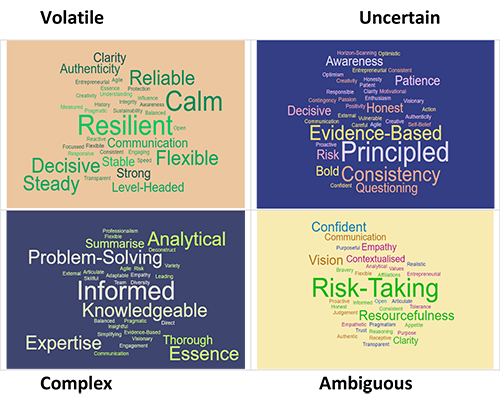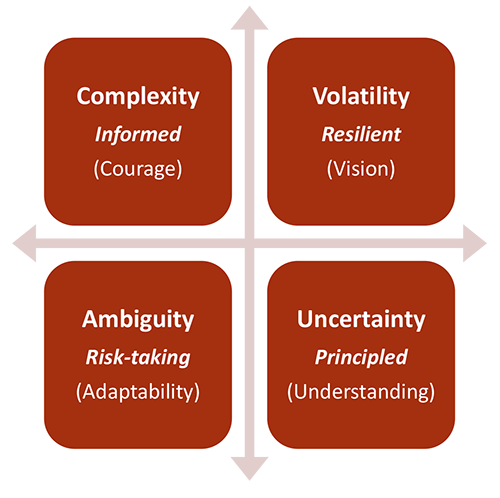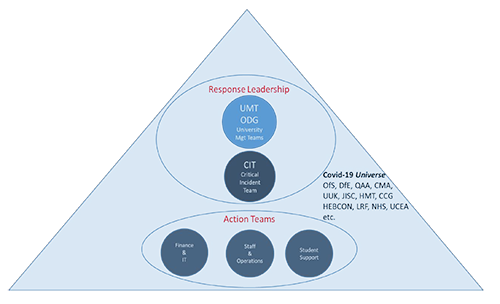
By Professor Nick Petford, Vice Chancellor, University of Northampton
18 May 2020
When the wind of change blows, some build walls, while others build windmills (Chinese proverb)
Back in the good ‘old normal’ days (July 2019) I was asked by AdvanceHE, along with the then Chair of the University of Northampton Board, to discuss how the sector should face uncertainty in the year ahead. The audience comprised senior leaders from management teams, plus a fair smattering of Board and Council members, from over 40 universities. Little did we know that real ‘uncertainty’ would soon turn the world on its head, and that this theoretical exercise on academic risk management could now hold a key to institutional success or failure in a new Covid-19 world.
A VUCA World
The acronym VUCA (Volatile, Uncertain, Complex, Ambiguous) was first introduced in 1987 by the US Military to help define the post-Cold War global security environment. Since the early 2000s, it has been applied increasingly to strategic thinking and risk management across a wide range of industries, from commerce to education. VUCA brings together four discrete challenges that demand four separate counters. The key is to ensure that individual answers to each challenge mesh together to form a response greater than the sum of the parts.
VUCA in UK HE
The task set for the group was to populate a VUCA matrix from an institutional perspective and then map onto that the leadership and governance traits considered most appropriate in the context of our sector. The results would then be benchmarked against a theoretical corporate response to VUCA identified in 2014 by N. Bennett & G. J. Lemoine, researchers at Harvard Business School. Participants were pushed to think about those characteristics that would define a meaningful VUCA world for their own institution. Each VUCA component was summarised, as below, to provide a common perspective with the group then tasked to develop their own, unique response.
|
Volatile: quick actions needed to events outside your control |
Uncertain: future unclear and non- predictable |
|
Complex: Dynamic networks with confusing/conflicting relationships |
Ambiguous: Action without certainty of outcome |
To begin with it was hard work. Most discussion, perhaps understandably, was focused on immediate, short term risks to mitigate relatively benign (in the face of Covid-19) challenges, including falls in student numbers industrial action, negative REF/TEF/KEF outcomes and over-zealous regulation. But none of these things really hit the spot. The exchange opened up only when the group were challenged to respond to real-life examples of crisis management and business continuity in HE, drawn in part from successful UCEA crisis communications conferences I have chaired on this very topic where unforeseen events had put infrastructure and lives at risk.
Reaping the results
Groups were asked to come up with words they felt best described their institutions’ response to each VUCA. These were then analysed for frequency and weight to develop word clouds and the most frequent word per VUCA category identified:
The response was then mapped onto a 2 x 2 matrix with axes defining “what you know” versus the “outcomes/forecasts of your actions”. The most frequent word per category is displayed in italics in Figure 2. For UK HE, read: Volatility = Resilient, Uncertainty = Understanding, Complexity = Informed, Ambiguity = Risk-taking.
Summary of HE participant’s response to VUCA challenges (italics). For comparison, words in brackets have been proposed as most relevant to the (pre Covid-19) corporate world.
VUCA in action in response to Covid-19
Of course, all our universities are rising the challenge of the very real crisis we all face. Wonkhe’s Debbie McVitty recently reported on how many are even using the crisis as an opportunity for innovation in ‘From crisis to creativity’.
At Northampton we have used components of the VUCA model to underpin our rapid response to Covid-19. Instead of the top-down Gold-Silver-Bronze command structure we have restructured around the concept of a Network of Teams. This problem-solving response confers authority and decision making across a distributed but interconnected network, following a commonly agreed set of priorities. In our model, three action teams form the integrated nerve centre, reporting to and guided by a single Critical Incident Team (Response Leadership). All are time limited. As the situation stabilises, the Critical Incident Team will be replaced by a Business Recovery Group, with membership expanded to include representatives from the student and trade unions.
The two VUCA challenges that capture best our response to Covid-19 are Complexity and Volatility. Our crisis management response has been driven by the realisation that the situation has many interconnected parts, and while some information is always available or can be predicted, it is at times overwhelming (Complexity). However, while the challenge is unexpected and of unknown duration, it is not beyond comprehension, even though decisions will need to be made before all the facts are evident (Volatility). Our Network of Teams model is optimised to deliver the most effective management response as a function of available resources and time. From a VUCA perspective, three Action Teams deal with Complexity and the Response Leadership teams manages Volatility:
The Covid-19 pandemic will come to an end, so it’s important that the future is not crowded out by focusing exclusively on the present. This forward gaze is maintained through the University Management Team with input from the University Board. Of course, what works for us at Northampton may not be appropriate elsewhere. But in the end, universities will be judged by staff, students and stakeholders by how they acted, not what they said. Despite the pandemic, much that is new and positive will come from this experience, including what to do even better next time round.






